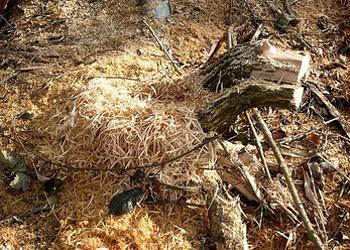
LEUVEN, Belgium, December 1, 2014 (ENS) – Belgian researchers have found a way to convert ordinary sawdust into building blocks for gasoline.
Using a new chemical process, scientists led by a team at the Katholieke Universiteit Leuven’s Centre for Surface Chemistry and Catalysis were able to convert the cellulose in sawdust into hydrocarbon chains.
The researchers call them “green hydrocarbons” and say they can be used as an additive in gasoline, or as a component in plastics.
“Our method could be especially useful in Europe, where we have little crude oil and cannot easily produce shale gas,” said Professor Bert Sels at KU Leuven.

“Our product offers an intermediate solution for as long as our automobiles run on liquid gasoline. It can be used as a green additive – a replacement for a portion of traditionally-refined gasoline,” said Sels.
But the possible applications of the new hydrocarbons go far beyond gasoline.
“The green hydrocarbon can also be used in the production of ethylene, propylene and benzene – the building blocks for plastic, rubber, insulation foam, nylon, coatings and so forth,” Sels explained.
“We are currently facing shortages in this because it is becoming quite difficult and more expensive to distil these specific hydrocarbon chains from crude oil or shale gas,” said Sels. “In time, hydrocarbon derived from cellulose may provide an alternative.”
This research foreshadows a future in which bio-refineries will be key to the manufacture of transportation fuels, chemicals and materials.
“This is a new type of bio-refining, and we currently have a patent pending for it,” said Dr. Bert Lagrain at KU Leuven.
“We have also built a chemical reactor in our lab,” explained Lagrain. “We feed sawdust collected from a sawmill into the reactor and add a catalyst – a substance that sets off and speeds the chemical reaction.”
“With the right temperature and pressure, it takes about half a day to convert the cellulose in the wood shavings into saturated hydrocarbon chains, or alkanes,” he said.

Cellulose is the main substance in plant matter and is present in all non-edible plant parts of wood, straw, grass, cotton and old paper.
Often viewed as a nuisance byproduct in sawmills, sawdust does have other uses. It is used as fuel for industrial boilers, used to manufacture particleboard and wood pulp, charcoal briquettes and stove pellets and spread for mulch.
Now KU Leuven researcher Beau Op de Beeck has developed a new method to derive hydrocarbon chains from the cellulose in sawdust.
“The result is an intermediary product that requires one last simple step to become fully-distilled gasoline,” explained Sels.
“From an economic standpoint, cellulose has much potential,” said Sels. “Cellulose is available everywhere; it is essentially plant waste, meaning it does not compete with food crops in the way that first generation energy crops – crops grown for bioethanol, for example – do. It also produces chains of 5 to 6 hydrocarbon atoms – ‘light nafta’ in the technical jargon.”
At the molecular level, cellulose contains strong carbon chains. The researchers sought to conserve these chains, but drop the oxygen bonded to them, which is undesirable in high-grade gasoline.
“Essentially, the method allows us to make a petrochemical product using biomass, thus bridging the worlds of bio-economics and petro-chemistry,” said Dr. Lagrain.
The research team includes scientists from the Leibniz-Institute for Solid State and Materials Research in Dresden, Germany and the Chemical Engineering Department at the California Institute of Technology in Pasedena.
The researchers reported their findings in the journal “Energy & Environmental Science” in an article entitled, “Direct catalytic conversion of cellulose to liquid straight-chain alkanes.”
